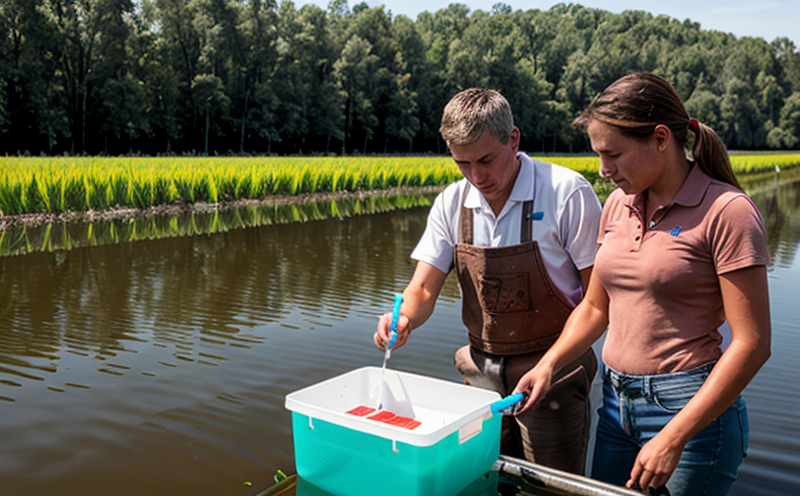Odor Testing in Agricultural Water
The detection and quantification of odors in agricultural water is essential to ensure that water used in farming practices meets quality standards. This testing helps prevent contamination, ensures compliance with environmental regulations, and supports the overall health and productivity of crops and livestock.
Agricultural water can originate from various sources such as irrigation systems, drainage ditches, or surface water bodies near farms. The odor profile of agricultural water is influenced by factors like soil type, climate conditions, and the presence of certain chemicals used in farming practices. It's crucial to monitor these odors because they can indicate potential issues with water quality that could harm crops, livestock, and local ecosystems.
The first step in conducting odor testing involves collecting representative samples from different points along the agricultural water source or distribution system. These samples should be collected following strict protocols outlined by relevant international standards such as ISO 14675:2013. The sample collection process must account for potential sources of contamination, ensuring that the integrity of each sample is preserved.
Once samples are collected, they undergo a series of preliminary analyses to determine their basic characteristics. This includes pH measurement, turbidity testing, and initial odor assessment using olfactometry techniques. Olfactometry involves trained personnel assessing the intensity and character of odors present in the water samples through human olfactory perception.
For more accurate quantification, instrumental methods may also be employed. Gas chromatography (GC) is widely used for identifying volatile organic compounds responsible for odor emissions. These instruments can separate complex mixtures into individual components allowing precise identification and measurement of each component contributing to the overall odor profile.
The interpretation of results requires expertise in both chemistry and agriculture sciences since the presence or absence of specific odorous compounds can have significant implications beyond just olfactory annoyance but also on plant health, soil quality, and animal welfare. Therefore, it is advisable to consult with professionals experienced not only within analytical laboratories but also familiar with agricultural practices.
Understanding the sources contributing to undesirable odors in agricultural waters allows for targeted mitigation strategies aimed at improving water quality. By addressing these issues early through regular monitoring and testing, farmers can maintain sustainable practices that benefit both their operations and the environment.
Why Choose This Test
Selecting odor testing services specifically tailored to agricultural water ensures accurate identification and quantification of odors present in irrigation systems, drainage channels, or other water sources used on farms. Such specialized laboratories possess the necessary expertise, equipment, and methodologies required for comprehensive analysis.
- Comprehensive Analysis: Professional odor testing services provide thorough assessments covering all aspects relevant to agricultural water quality including but not limited to pH levels, turbidity, temperature, and microbial content alongside odor evaluations.
- Trained Personnel: Ensures accurate interpretation of results which is crucial given the complexity involved in detecting subtle differences between various odorous compounds.
- Advanced Equipment: Utilization of state-of-the-art technology such as gas chromatography ensures reliable and consistent data collection, reducing variability in measurements.
- Regulatory Compliance: Meeting specific regulatory requirements helps avoid costly penalties associated with non-compliance or potential legal action related to environmental degradation caused by poor quality agricultural water usage practices.
Selecting a reputable laboratory ensures not only accurate and reliable results but also peace of mind knowing that your tests are conducted under strict quality assurance protocols. This approach supports informed decision-making regarding corrective actions needed to address any identified issues effectively.
Quality and Reliability Assurance
The quality and reliability of odor testing in agricultural water are paramount for maintaining the integrity and reputation of agricultural operations. To ensure consistent and accurate results, laboratories adhere strictly to international standards such as ISO 14675:2013 which provides guidelines on how to perform olfactometry tests effectively.
Quality assurance measures include rigorous training programs for personnel involved in sample collection, preparation, and analysis. Regular calibrations of instruments used during testing further enhance the accuracy of results obtained from these tests. Additionally, laboratories maintain thorough documentation records detailing every aspect of each test conducted, including initial observations made during field visits or laboratory evaluations.
Reliability assurance comes into play when ensuring that all tests yield consistent outcomes over time despite changes in environmental conditions affecting agricultural water quality. This is achieved through continuous monitoring and updating of protocols based on feedback received from clients as well as advancements in analytical techniques available within the scientific community.
By choosing a laboratory committed to maintaining high standards of quality and reliability, you can trust that your odor testing will provide valuable insights into potential problems affecting agricultural water quality. These insights allow for proactive measures aimed at mitigating risks associated with poor quality water usage practices while supporting sustainable agricultural operations.





